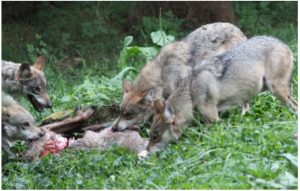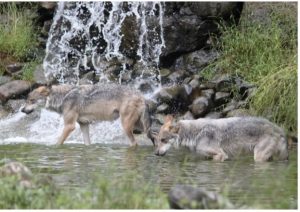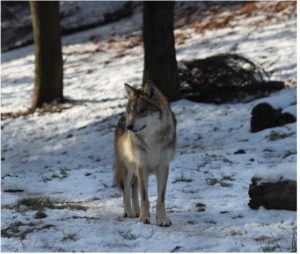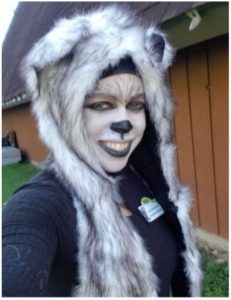

 Wolves have mystified and awed people for centuries. They have been featured in myths and legends across many cultures. This week we are showing them a little extra love as we howl for Wolf Awareness Week! We wanted to take a closer look at why wolves are so important to our environment and what we can do to help them.
Wolves have mystified and awed people for centuries. They have been featured in myths and legends across many cultures. This week we are showing them a little extra love as we howl for Wolf Awareness Week! We wanted to take a closer look at why wolves are so important to our environment and what we can do to help them.
Wolves are a keystone species… but ok, what does that mean? Being a keystone species means that your habitat relies on you for helping maintain balance and that if you were removed from that habitat, it would drastically change. For example, when wolf populations began to decline and disappear in Yellowstone, a domino affect was initiated that affected many different species of animals and plants living there. But wolves are carnivores; how could they possibly affect the plants in their habitat if they don’t eat them?
 In Yellowstone, wolves are an apex predator, which basically means that they are at the top of the food chain. Some of their main food sources are elk and deer. Without wolves there to hunt them and keep population sizes in check, elk and deer quickly overpopulated Yellowstone. Higher population levels meant that there were more mouths to feed. That domino led then to a decline in willow and aspen populations in Yellowstone. The affect didn’t stop there, however. With less willow and aspen trees, songbirds began to experience population decline, and beavers were not able to build their dams, which led to more stream erosion. These dominos then led to a rise in water temperatures because of less dams and less tree shade, which led to a decrease in cold water fish populations.
In Yellowstone, wolves are an apex predator, which basically means that they are at the top of the food chain. Some of their main food sources are elk and deer. Without wolves there to hunt them and keep population sizes in check, elk and deer quickly overpopulated Yellowstone. Higher population levels meant that there were more mouths to feed. That domino led then to a decline in willow and aspen populations in Yellowstone. The affect didn’t stop there, however. With less willow and aspen trees, songbirds began to experience population decline, and beavers were not able to build their dams, which led to more stream erosion. These dominos then led to a rise in water temperatures because of less dams and less tree shade, which led to a decrease in cold water fish populations.
 It almost seems unbelievable that all these changes happened just because the wolves were gone, but it’s moments like these that show us just how important it is to protect the animals, the plants, and the earth we share with them. In this case, wolves disappearing from Yellowstone was directly caused by human intervention. Wolves were seen as threats to livestock by farmers and threats to elk and deer populations living in the park, so it was decided that wolves needed to be removed. Over 136 wolves were killed between 1914 and 1926, and by the 1970’s, no wolves were found in Yellowstone.
It almost seems unbelievable that all these changes happened just because the wolves were gone, but it’s moments like these that show us just how important it is to protect the animals, the plants, and the earth we share with them. In this case, wolves disappearing from Yellowstone was directly caused by human intervention. Wolves were seen as threats to livestock by farmers and threats to elk and deer populations living in the park, so it was decided that wolves needed to be removed. Over 136 wolves were killed between 1914 and 1926, and by the 1970’s, no wolves were found in Yellowstone.
 Thankfully, people across the United States have banded together to help save this beautiful ecosystem and restore its biodiversity and also to help bring wolves back from the brink of extinction. In 1995, the process began of introducing wolves back into Yellowstone. There have been ups and downs since then, but it is still exciting to have wolves back in Yellowstone and to see the land there beginning to recover.
Thankfully, people across the United States have banded together to help save this beautiful ecosystem and restore its biodiversity and also to help bring wolves back from the brink of extinction. In 1995, the process began of introducing wolves back into Yellowstone. There have been ups and downs since then, but it is still exciting to have wolves back in Yellowstone and to see the land there beginning to recover.
Passionate people caring about animals and doing what they can to help them is the only way we are going to be able to help preserve incredible animals like our wolves and the ecosystems they are part of. There are many easy ways that you can make a difference in their lives today! One important way is by making changes at home like reducing waste and recycling. This helps improve the environment we share with these animals and can help protect resources we share with them. Another way is by following legislature being voted on and letting your politicians know that protecting animals and the land they live on is important to you. Vote for politicians that support your viewpoints and will support topics that are meaningful to you.
 One additional way is by supporting organizations that provide care to wolves, do research on them, or help with breeding and reintroduction. These organizations often rely on donations to help them provide the animal care or education programs that they provide. The Lehigh Valley Zoo supports several wolf conservation groups including: the Wood River Wolf Project, the Wolf Conservation Center, and the Endangered Wolf Center. To help us with providing care for our wolves, you can symbolically ADOPT one of our wolves through our website. Every ADOPT An Animal Includes: a plush animal, a personalized Certificate of Adoption, a photo of your adopted animal, a Fact Sheet with information about your animal, two (2) child admission tickets or one (1) adult admission ticket to the Zoo. Make your howl for wolf conservation heard today by choosing how you will support wolf conservation!
One additional way is by supporting organizations that provide care to wolves, do research on them, or help with breeding and reintroduction. These organizations often rely on donations to help them provide the animal care or education programs that they provide. The Lehigh Valley Zoo supports several wolf conservation groups including: the Wood River Wolf Project, the Wolf Conservation Center, and the Endangered Wolf Center. To help us with providing care for our wolves, you can symbolically ADOPT one of our wolves through our website. Every ADOPT An Animal Includes: a plush animal, a personalized Certificate of Adoption, a photo of your adopted animal, a Fact Sheet with information about your animal, two (2) child admission tickets or one (1) adult admission ticket to the Zoo. Make your howl for wolf conservation heard today by choosing how you will support wolf conservation!
Written by Tara Mlodzienski
Education Specialist
Lehigh Valley Zoo | Schnecksville, PA
Sources:
Photo Credit: Volunteer Nancy